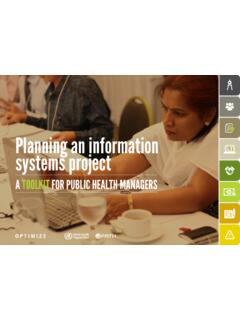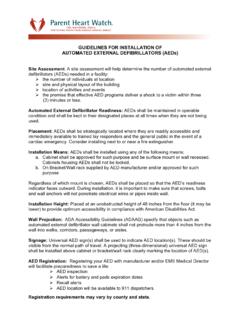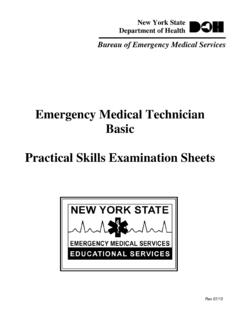Transcription of THE INCINERATOR GUIDEBOOK
1 VERSION 1 MARCH 2010 THE INCINERATOR GUIDEBOOK A practical guide for selecting, purchasing, installing, operating and maintaining small-scale incinerators in low-resource settings ii The INCINERATOR GUIDEBOOK A practical guide for selecting, purchasing, installing, operating, and maintaining small-scale incinerators in low-resource settings Acknowledgements The MMIS project is a five-year initiative funded by PEPFAR through the USAID and the Centers for Disease Control and Prevention (CDC). MMIS is implemented by JSI in collaboration with PATH, academy for educational development (AED), and the Manoff Group. The goal of the MMIS project was to establish an environment where patients, health care workers, and the community are better protected from the medical transmission of human immunodeficiency virus (HIV) and other bloodborne pathogens by project close (2009).
2 This report is intended to be used as a practical guide for selecting, purchasing, installing, operating, and maintaining small-scale incinerators in low-resource settings. This report was prepared under the auspices of the subagreement IS-002-09 modification between PATH and JSI for the MMIS project under JSI s Cooperative Agreement 5U62PS124534-05. PATH collaborates on health care waste management (HCWM) issues with partners such as the World Health Organization (WHO) and John Snow, Inc. (JSI), as well as ministries of health and private-sector collaborators. A comprehensive HCWM resource page is available on PATH s website at Disclaimer The author s views expressed in this publication do not necessarily reflect the views of the Office of the Global AIDS Coordinator (OGAC), the CDC, USAID or the United States Government.
3 Iii Table of Contents I. Introduction ..1 Purpose and approach ..1 Background ..1 The role of incineration ..2 II. Understanding INCINERATOR Combustion 101 ..4 Auto-combustion Fuel-assisted incinerators ..5 Temperature ..5 Residence Fuel to waste Lifecycle ..6 III. Selecting an Appropriate INCINERATOR ..7 Key steps for selecting an INCINERATOR design ..7 Budgeting for capital, operational, and recurrent IV. Best Practices for Procurement of Small-Scale 10 Program planning .. 10 Procurement .. 14 Performance .. 16 V. 17 Site selection .. 17 Protective 17 Ash pit ..18 Fuel storage .. 18 Water 18 Glass 19 Placenta pit .. 19 Equipment inspection .. 19 VI. Training and Supervision .. 20 VII. Operation and Safety 21 Health worker safety .. 21 Proper operation.
4 21 VIII. Maintenance and Repair .. 24 Scheduled 24 Operator 24 IX. Available Technologies .. 26 X. Additional Resources .. 27 ivAnnex 1: Small-Scale INCINERATOR Buyer s Guide .. 28 Annex 2: Examples of Tenders for Construction and Installation of Small-Scale Incinerators .. 33 Annex 3: Specifications for Future WDU Constructions in 43 Annex 4. Personal Protective Equipment for INCINERATOR Operators .. 45 Annex 5: Personal Protective Equipment Specifications for INCINERATOR Operators 46 Annex 6: Job Aid for INCINERATOR 51 Annex 7: Maintenance Checklist for INCINERATOR 52 v Acronyms and Abbreviations HCWM Health care waste management JSI John Snow, Inc. WHO World Health Organization CDC Centers for Disease Control and Prevention AED academy for educational development USAID United Sates Agency for International development HCW Health care waste PQS Performance, quality, and safety WDU Waste disposal unit Btu/kg British thermal units per kilogram EPA Environmental Protection Agency EU European Union PVC Polyvinyl choloride 1 I.
5 Introduction Purpose and approach This GUIDEBOOK is intended to be a practical guide for selecting, purchasing, installing, operating, and maintaining small-scale incinerators in low-resource settings. Small-scale refers to incinerators with a capacity to destroy approximately 12 to 100 kilograms of waste per hour. For the duration of this document, the term INCINERATOR will refer to small-scale incinerators. This guide was designed to help program planners address the challenges of safe management of health care waste (HCW). Every country and health setting faces different challenges to managing HCW safely. There is no one solution or technology that meets all needs. Programs must spend time to effectively plan and introduce any treatment solutions. The following information has been gathered to assist with this process.
6 This resource approaches the challenge of final disposal by providing key information on the following areas: Understanding INCINERATOR performance. Available technologies. Selecting an appropriate INCINERATOR . Best practices for procurement of small-scale incinerators. Installation. Training and supervision. Operation and safety. Maintenance and repair. To date, developing countries have had more experience with brick incinerators and this guide reflects that experience. As more, lower-cost INCINERATOR technologies become available and are introduced in low-resource settings, it will be important to publish and share these experiences with the global community. Background Developing countries face an urgent need for affordable, safe, and appropriate solutions for treating infectious waste.
7 Without treatment by heat, steam, or chemicals, used needles and syringes ( , sharps ) can cause infection and injury. Untreated safety boxes filled with used sharps pile up outside health facilities, allowing easy access by curious children or animals. Even if immunization programs specify that safety boxes must be treated according to national policies and standards, programs in low-resource countries may be forced to resort to whatever means are available to dispose of infectious waste. One common approach is burning infectious waste in a shallow pit, which generates toxic emissions and leaves behind melted plastic as well as needles that are often still sharp and infectious. Additional risks include environmental impacts to air and water quality. Managing infectious medical waste in developing countries has become an increasingly complex issue.
8 Global standards for acceptable performance of health care waste management (HCWM) do not exist. At the national level, policies are often lacking. Technological solutions are limited. In an attempt to address the dangers, products, needs, and environments are often mismatched. Appropriate technology combined with support and increased awareness has the immediate potential to substantially improve waste management practices in many countries. The World Health Organization (WHO) advocates for a relative risk approach to waste treatment that is, weighing the health risks from environmental exposures against the risks posed by accidental infection from poorly managed infectious waste (particularly sharps). WHO has indicated that until the infrastructure and resources are available, there is a need for immediate 2improved solutions for waste treatment that are appropriate for low-resource settings.
9 WHO also recognizes the need to identify feasible and cost-effective approaches that minimize environmental damage. The trend in the developed world has been toward environmentally friendlier waste treatment solutions such as autoclaving and shredding of sharps, which destroys pathogens, prevents the potential for reuse, and reduces waste volumes. However, the higher cost of these technologies, lack of durable designs, and the lack of reliable electrical supplies in many developing countries has prevented these technologies from being widely used. The role of incineration Until new, appropriate, non-incineration technologies that respond to infrastructure and cost limitations are identified, incineration is a valuable, medium-term solution for safely treating and disposing of infectious waste including sharps in many resource-limited settings.
10 Incineration uses combustion to make infectious medical waste harmless and reduce the waste mass and volume by more than 90 percent. Proper incineration can convert certain wastes into gases and incombustible solid residues ( , ash) that are relatively harmless. A dual-chamber INCINERATOR operated within the optimal temperature range of 650 to 1,000 C results in a lower level of emissions. The gases from incineration are released into the atmosphere (with or without gas cleaning). Residue ash from proper incineration can be encapsulated in designated ash pits or controlled landfills without any major risk. However, when the conditions are not adequate for example, when the waste is not properly segregated or the INCINERATOR is not properly constructed or operated toxic compounds can be found in the unburned waste, and harmful gases can be released into the atmosphere.

















